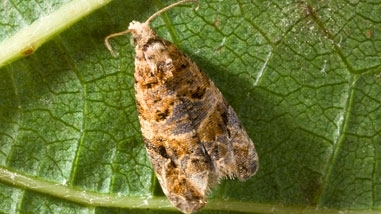European Grapevine Moth

Jack Kelly Clark, Regents of the University of California
European grapevine moth (Lobesia botrana) is a significant pest of berries and berry-like fruits. It feeds on the flower or fruit of host plants, most often grapes. The moth is a significant agricultural pest throughout much of the world. It was first detected in the United States in California in 2009 and fully eradicated in 2016.
Today, APHIS continues to support the California Department of Food and Agriculture's (CFDA) annual European grapevine moth survey and monitors grape imports to maintain our pest-free status.
All varieties of wine and table grapes are susceptible to this pest. If populations are high enough, the caterpillar can also feed on less preferred hosts such as olives, persimmons, cherries, nectarines, and pomegranates.
Here's what to look for:
- Moths
- The moths have creamy white forewings mottled with gray-blue, brown, and black markings.
- Both males and females have similar mosaic-patterned wings.
- Caterpillars
- Larvae have a yellowish-brown head with short and retracted antennae.
- They are about 9-10 millimeters long and vary in color from yellowish-green to whitish-brown, completely brown or completely translucent.
- Brown and rotting fruit
- Berries can become damaged through a fungus called botrytis, also known as bunch rot.
- Rolled leaves or clusters of leaves or flowers tied with silk
European grapevine moth spreads most commonly via infested grape clusters, vine clippings, nursery stock, and grape production equipment.
Here's what you can do to prevent this:
- Do not bring or mail fresh fruits, vegetables, or plants into your State or another State unless agricultural inspectors have cleared them first.
- Cooperate with agriculture officials who may be in your area surveying for the pest.
- They may ask for access to your property to place and check insect-monitoring traps.
Report Plant Pests and Diseases
Have you seen this pest or signs of pest damage? Immediately report your findings.
Find your State plant regulatory official
Find your State plant health director
Controlling European Grapevine Moth
The United States has been free of European grapevine moth since 2016. To keep it that way, we have a strong safeguarding program in place. The program includes:
- Monitoring for the pest in at-risk areas (grape-growing regions in California)
- Science-based import regulations to prevent the pest's reentry via host plant materials
- Ongoing public outreach
Identifying European Grapevine Moth
There are many types of tortricids that can be confused for European grapevine moth and other moths. Adult moths must be identified by a qualified entomologist. Larval stages cannot be reliably identified using morphological characters.

